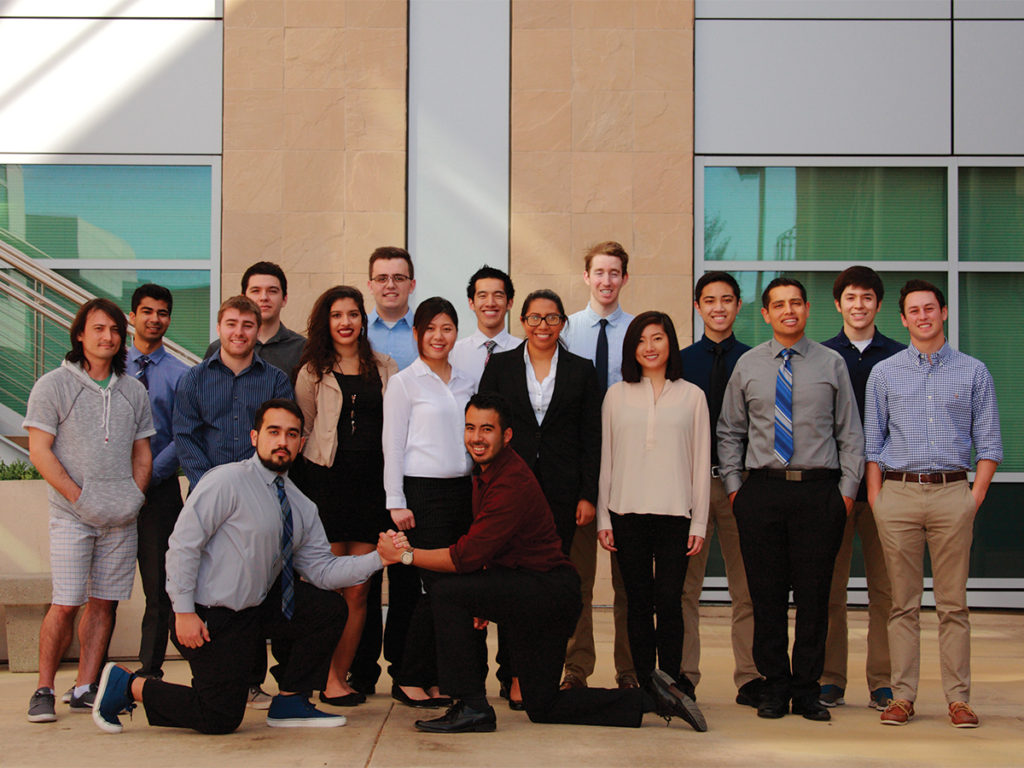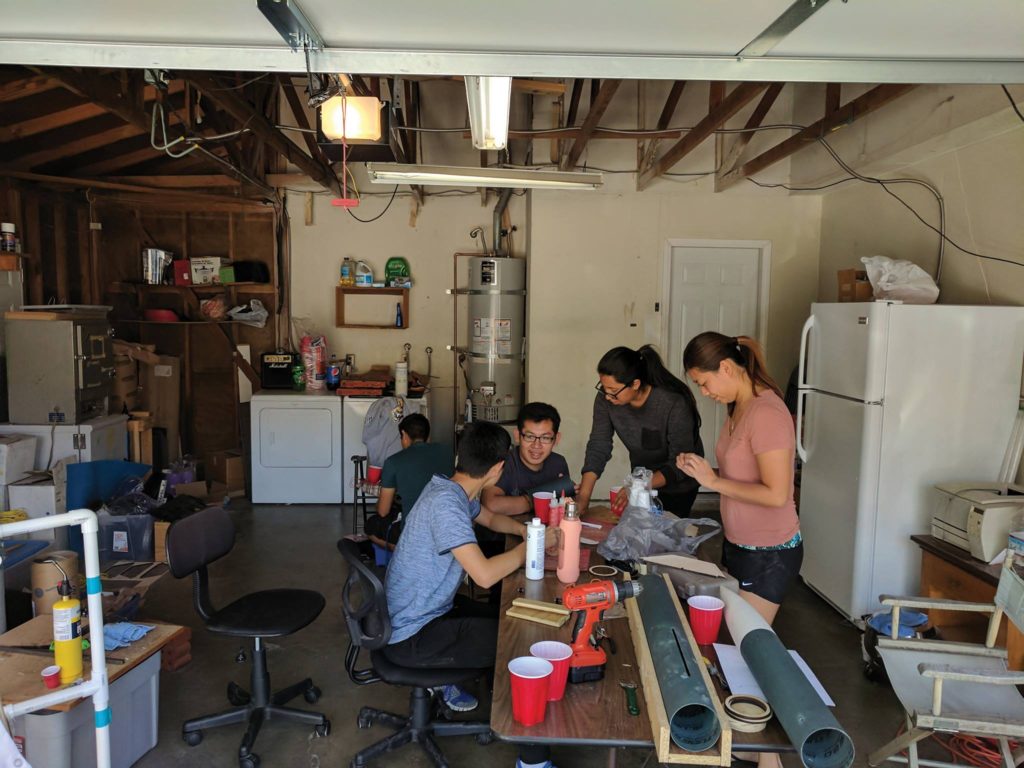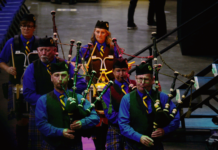
Courtesy of Aerospace Systems
Convening in a medium-sized study room on the first floor of Orbach library on Friday (their regular meeting day), May 12, a passionate group of college students were intently discussing the expansion of the only student-run aerospace organization on campus — Aerospace Systems — going over their tabling efforts, then spotlighting a few members who had contributed above and beyond that week.
With the 2016-2017 school year being their first year as an official student organization at UCR, however, the club had already fostered an exceptionally sizable amount of active participants and held a solid team of dedicated officers; while on the topic of the importance of teamwork during a comprehensive roundtable discussion, one of them, president and fourth-year mechanical engineering Xavier Hernandez, even drew a reverse triangle diagram. The president’s position was at the tip and the vast majority of the positions — the project marketers — were the base, with Hernandez commenting, “The most fulfilling part of my position is seeing the project marketers come together and work as hard as they do … Because at the end of the day, the purpose of this club is to unite people to achieve a common goal that can’t be achieved alone.”
Flashback to last year when there was no Aerospace Systems but instead a group of friends who united through their interest in aerospace engineering. Propulsion lead and fourth-year mechanical engineering major Steven Luna shared, “Before the club even existed, it was just a small group of us working on a rocket project. We were pretty nervous in the beginning because we didn’t know what to expect going in. But when we were testing rockets in the desert and applying our work hands-on, we all got hooked.” On becoming a member of the group during its first academic year as a student organization under Student Life, first-year statistics major Stephanie Sayson added, “It was really exciting at first but also very daunting; a lot of it was completely new to me. But the environment really encouraged me to stick around.”
Now, by looking around the room of 15 to 20 or so deeply focused and engaged students, one would notice that a portion of the students in Aerospace Systems, like Sayson, are not mechanical engineers or even in the Bourns College of Engineering (BCOE). Hernandez explained the importance in embarking on a multidisciplinary approach to outreach and club activities besides just the science and avionic aspects of the club. Particularly with the humanities, “Arts and film are a part of engineering. Any action comes from emotional reaction. Movies like Star Wars enforce positive emotions about science and motivate lots of people to be curious about it.”
Because at the end of the day, the purpose of this club is to unite people to achieve a common goal that can’t be achieved alone.
Most of all, the club opens its arms to people from every discipline by ensuring that each member has their own niche tuned to their capabilities and interests. Chief engineer and fourth-year mechanical engineering major Roberto Hernandez expressed that an objective of the organization is “to get people at UCR involved and exposed to aerospace, and that means to get people of all majors involved. It’s a human effort.” Fourth-year mechanical engineering major Jenny Martinez added, “There’s not many female engineers, so it’s cool to see other young girls interesting in something they thought they were not capable of doing.” From glancing around the table, the constituency contained a nearly even ratio of male to female students.
Where this mutualistic team effort truly takes its mold is in what they call their weekend work days, generally a Saturday. Martinez explained, “Each work day, we have our various teams come together like our structures team, avionics team … In what we call our ‘rocket-house,’ we get together and each respective team works together. It’s a place where we can all communicate effectively between each team and really get to work on manufacturing and marketing skills.” In terms of marketing, third-year engineering major and upcoming recruitment chair Sam Robinson explained, “We maintain an artistic aspect, because for people who are not familiar with aerospace — what it is and could be — they can understand the concept through art and visuals.” Vice president and first-year materials science and engineering major Bryan Le clarified it is important to have flexibility in the club and to encourage everyone to provide their input, in alliance with the organization’s cherishment in performing beyond what is expected of each individual, stating, “Although we are a very structured organization, members are not limited to a singular title. Members can go beyond the scope of the roles because it’s really important to get insight from everyone on outreach, project and managerial aspects.”

Courtesy of Diana Tse
Currently, the team is working on a project for the IREC Spaceport America Cup, which, according to their GoFundMe page, “is the largest intercollegiate rocket-engineering competition in the nation” and will assess a rocket that has been manufactured by a team of students based on a variety of factors, such as performance, how well it flies and the design. This is the first year that UCR will be competing, and according to upcoming avionics and controls lead and second-year mechanical engineering major Ryan Balleza, “this is the year we make a statement, make a name and legitimize ourselves as an organization.” Controls and avionics lead and third-year mechanical engineering major Andres Sanchez Paredes described how UCR stands out in the competition: Because “all of the other schools have tons of money dumped onto them, such as UCI, who received a $1 million grant. With us, we only have scraps and bits of money from our GoFundMe and ASUCR.” Hernandez wanted to also dedicate much of their appreciation to BCEO for offering them “lots of support, odd jobs and a community,” even though they are not a BCEO-affiliated organization.
The competition will be taking place June 2017 in New Mexico, and the team has been avidly dedicating their work days to constructing a rocket that Sanchez Paredes hopes will win the first-place prize for Aerospace Systems (but also clarified that he could not speak of on behalf of the entire club because everyone could have their own expectations regarding the event). However, beyond a single esteemed competition is the desire to exceed the expectations placed on a college aerospace club. When asked what the ultimate goal of the club is, Hernandez voiced, “To make a positive difference in the community: Nothing bigger or smaller.” Earlier in the meeting, he had drawn a flowchart of the aspiring organization’s plans for the future, with (moving from the bottom-up) IREC, followed by space, then orbital, then moonshot, then Mars. No one flinched at the mentioning of the word “Mars” as a spectator would be taken-aback by, but it comes with no surprise: Just as everyone else seemed to have ingrained and determined in their mindsets, Hernandez declared, “Anything is possible with hard work and people.”
You can visit Aerospace Systems’s GoFundMe page at https://www.gofundme.com/AerospaceSystemsUCR, as well as their Facebook and HighlanderLink at “Aerospace Systems UCR.” Their newly renovated website is http://aerospacesystems.weebly.com/.








